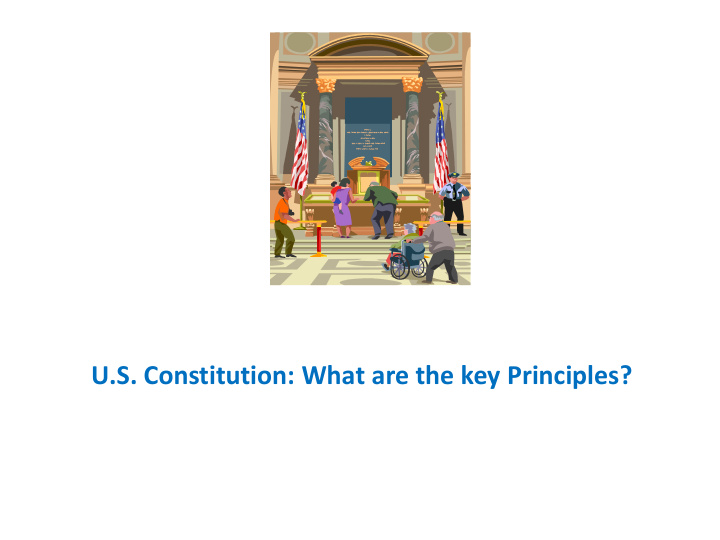



U.S. Constitution: What are the key Principles?
We have talked about Democracy Will of the people, representation, elections, rights, and rule of law, political equality Democracy American style- protective, developmental, pluralist, and participatory Cross – cutting elements- goals, role of citizen, institutional mechanisms, equality, and character of human nature YET, what are the underlying principles that enable the people to pursue opportunity, prosperity, and property?
The American Political Culture and Enduring Concerns/Balance Role of government Balance of conflict and competition and resolution Fostering Cooperation Establishing and maintaining community Ensuring basic rights and societal obligations The rules of the games and facilitating widespread participation
Core Value #1- Liberty Individual liberty- economic, religious, personal. All persons having equal worth Natural rights- our inalienable rights=>life, liberty and pursuit of happiness Immediate inclusion of the Bill of Rights Rights are not absolute Concept of citizenship- responsible to participate in public life Will of the people is paramount
Core Value #2 Political Equality- all free/ encouraged to participate All have equal standing before government & its agents All have equal rights Distinction of citizenship status and suffrage rights Are there a basis for differential rights ? Protective or legal standing and protections
Core Value #3- Popular Sovereignty Ruled by the people Final authority in the hands of the people Self-governance (have interest, capabilities, intelligence to govern) Agree upon representative government
Core Value #4 - Majority Rule Representatives chosen by the greatest numbers All must go along with the policy/legislative outcomes The majority that produces the outcomes is not always the same majority Majority rule reflects the modal sentiment of the populace
Core Value #5- Minority Rights Original emphasis on political and religious minorities Minority represented those not part of the prevailing majority based upon a variety of distinctions / interests Need for a delicate balance of having an operational government that can function and avoid the excesses of arbitrary rule. Avoid abuse of power by merely numbers
Core Value # 6- Economic Rights Right to own property Limited role of government to regulate economic activities Extreme abuses of economic activities subject to anti-trust laws Government can involve itself in regulating unfair business practices to protect individual rights Can well be wealth inequalities among individuals and entrepreneurs but not responsibility of government to ensure economic equality
Core Value #7- Government as Responsive Expectations by the people to make demands on government Will be competing publics For government to be responsive , people need to participate Government responsive to voiced opinions and concerns Govt. as responsive if active citizenry and not couch potatoes All have responsibility to be national citizens Government responsive to actions of citizenry Governance an interactive process between people and their government
Core Values/Principles #8 - Separation of Powers & Checks and Balances Interdependence of governmental institutions- decentralize decision- making Some unique powers for specific political institutions (war, appropriations, impeachment, etc. ) Staggered terms, different constituency bases, required agreements, veto, branches of government Judicial oversight, people’s input on representatives and amendment process, some popularly elected, others elected indirectly
Core Value/Principle #9- Federalism Divisions of governments- standing and powers (Federal and state governments Areas of authority and responsibility- mutual, exclusive, and reserved powers Original jurisdictions- variation of state structures and offices from national government
Federalism Concept of federalism- dual vs. cooperative Constitutional principles/sections – necessary and proper, elastic clause, explicit Basic issues of federalism- scope of government, what role to play in times of crisis, Examples- Brown v. Board of Education, Voting Rights Act, Civil Rights Act, War on Poverty, reapportionment Why expansion of federal role? – interest groups, crisis, default of states Conflicts of states vs. national government- immigration
Development of Federalism Patterns Changing federalism pattern- reduce scope , size of bureaucracy, transfer control to states Sub-national governments- municipalities, counties, school districts, regional special districts WHY SHIFTS- Civil War, 14 th amendment, 16 th amendment, use of sticks and carrots (legislation and funding), court cases, politics Financial federalism- categorical grants, block grants, revenue sharing, formula grants Key court decisions- McCullough v. Maryland, Dred Scott, Hammer v. Dagenhart, the New Deal, Brown v. Board of Education , Civil Rights Act ’64 Nixon’s new federalism; Reagan’s state’s initiatives, decentralization
Is Federalism Necessary? Answer NO- if there are not different problems, an inefficient system; to much duplication; national government too remote Answer YES- if states not responsive, wealth inequalities; pluralism and enhancing sense of national community Role of citizen participation – informed public; access to any level; insure fullest participation; maximize responsiveness Variations of democracies- neighborhood democracies; adversary democracies; unitary democracy; representative democracy
Gun Violence in America What are the issues involved in this area? Are there underlying social and cultural factors? How does government figure into this realm? Are there legal issues and Contitutional issues?
Second Amendment “A well regulated Militia being necessary to the security of a free state, the right of the people to keep and bear Arms should not be infringed”
What should or needs to be the government’s response to violence, and especially gun violence? What is the role of the citizenry? What about the states and policies/laws regarding guns? Is their a viable social, political and legal balance in this area?
Exam Schedule for POL 210- Fall Semester, 2008 Exam # 1 — September 23 rd Exam #2 – October 28 th Exam #3 – November 18 th Exam #4 – December 16 th at 2:00
Recommend
More recommend